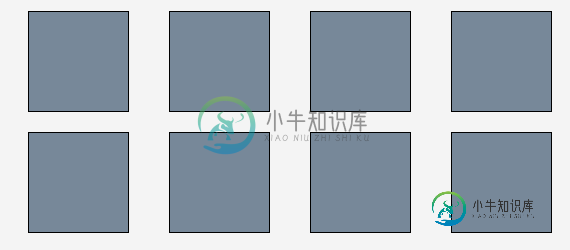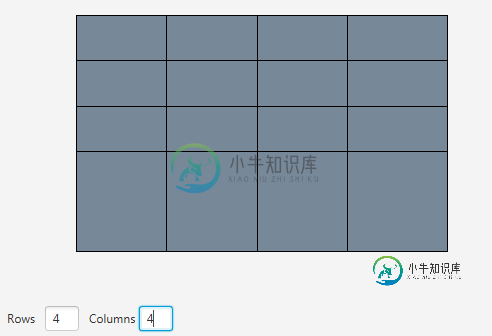在JavaFX中向固定大小的GridPane动态添加元素
我想在JavaFX中显示一个包含不同数量矩形的网格。重要的是不能调整此网格的大小。
我选择了GridPane布局。我动态地将javafx.scene.shape.rectangle添加到它中。下面是我的网格看起来像2行4列。

在调整大小时,我希望它保持相同的整体形状,也就是说每个矩形具有相同的大小,并且在我的矩形之间保持水平和垂直间隙。

-
null
public void refreshConstraints() {
getRowConstraints().clear();
getColumnConstraints().clear();
for (int i = 0; i < nbRow; i++) {
RowConstraints rConstraint = new RowConstraints();
// ((nbRow - 1) * 10 / nbRow) = takes gap into account (10% of height)
rConstraint.setPercentHeight(100 / nbRow - ((nbRow - 1) * 10 / nbRow));
getRowConstraints().add(rConstraint);
}
for (int i = 0; i < nbColumn; i++) {
ColumnConstraints cConstraint = new ColumnConstraints();
cConstraint.setPercentWidth(100 / nbColumn - ((nbColumn - 1) * 10 / nbColumn));
getColumnConstraints().add(cConstraint);
}
}
import javafx.application.Application;
import javafx.application.Platform;
import javafx.beans.value.ChangeListener;
import javafx.beans.value.ObservableValue;
import javafx.scene.Scene;
import javafx.scene.control.Label;
import javafx.scene.control.TextField;
import javafx.scene.layout.BorderPane;
import javafx.scene.layout.ColumnConstraints;
import javafx.scene.layout.GridPane;
import javafx.scene.layout.HBox;
import javafx.scene.layout.RowConstraints;
import javafx.scene.paint.Paint;
import javafx.scene.shape.Rectangle;
import javafx.stage.Stage;
public class DynamicGrid extends Application {
//Class containing grid (see below)
private GridDisplay gridDisplay;
@Override
public void start(Stage primaryStage) {
//Represents the grid with Rectangles
gridDisplay = new GridDisplay(400, 200);
//Fields to specify number of rows/columns
TextField rowField = new TextField();
TextField columnField = new TextField();
//Function to set an action when text field loses focus
buildTextFieldActions(rowField, columnField);
HBox fields = new HBox();
fields.getChildren().add(rowField);
fields.getChildren().add(new Label("x"));
fields.getChildren().add(columnField);
BorderPane mainPanel = new BorderPane();
mainPanel.setLeft(gridDisplay.getDisplay());
mainPanel.setBottom(fields);
Scene scene = new Scene(mainPanel);
primaryStage.setTitle("Test grid display");
primaryStage.setScene(scene);
primaryStage.show();
}
/**
* @param args the command line arguments
*/
public static void main(String[] args) {
launch(args);
}
private void buildTextFieldActions(final TextField rowField, final TextField columnField) {
rowField.focusedProperty().addListener(new ChangeListener<Boolean>() {
@Override
public void changed(ObservableValue<? extends Boolean> ov, Boolean t, Boolean t1) {
if (!t1) {
if (!rowField.getText().equals("")) {
try {
int nbRow = Integer.parseInt(rowField.getText());
gridDisplay.setRows(nbRow);
gridDisplay.updateDisplay();
} catch (NumberFormatException nfe) {
System.out.println("Please enter a valid number.");
}
}
}
}
});
columnField.focusedProperty().addListener(new ChangeListener<Boolean>() {
@Override
public void changed(ObservableValue<? extends Boolean> ov, Boolean t, Boolean t1) {
if (!t1) {
if (!columnField.getText().equals("")) {
try {
int nbColumn = Integer.parseInt(columnField.getText());
gridDisplay.setColumns(nbColumn);
gridDisplay.updateDisplay();
} catch (NumberFormatException nfe) {
System.out.println("Please enter a valid number.");
}
}
}
}
});
}
//Class responsible for displaying the grid containing the Rectangles
public class GridDisplay {
private GridPane gridPane;
private int nbRow;
private int nbColumn;
private int width;
private int height;
private double hGap;
private double vGap;
public GridDisplay(int width, int height) {
this.gridPane = new GridPane();
this.width = width;
this.height = height;
build();
}
private void build() {
this.hGap = 0.1 * width;
this.vGap = 0.1 * height;
gridPane.setVgap(vGap);
gridPane.setHgap(hGap);
gridPane.setPrefSize(width, height);
initializeDisplay(width, height);
}
//Builds the first display (correctly) : adds a Rectangle for the number
//of rows and columns
private void initializeDisplay(int width, int height) {
nbRow = height / 100;
nbColumn = width / 100;
for (int i = 0; i < nbColumn; i++) {
for (int j = 0; j < nbRow; j++) {
Rectangle rectangle = new Rectangle(100, 100);
rectangle.setStroke(Paint.valueOf("orange"));
rectangle.setFill(Paint.valueOf("steelblue"));
gridPane.add(rectangle, i, j);
}
}
}
//Function detailed in post
//Called in updateDisplay()
public void refreshConstraints() {
gridPane.getRowConstraints().clear();
gridPane.getColumnConstraints().clear();
for (int i = 0; i < nbRow; i++) {
RowConstraints rConstraint = new RowConstraints();
rConstraint.setPercentHeight(100 / nbRow - ((nbRow - 1) * 10 / nbRow));
gridPane.getRowConstraints().add(rConstraint);
}
for (int i = 0; i < nbColumn; i++) {
ColumnConstraints cConstraint = new ColumnConstraints();
cConstraint.setPercentWidth(100 / nbColumn - ((nbColumn - 1) * 10 / nbColumn));
gridPane.getColumnConstraints().add(cConstraint);
}
}
public void setColumns(int newColumns) {
nbColumn = newColumns;
}
public void setRows(int newRows) {
nbRow = newRows;
}
public GridPane getDisplay() {
return gridPane;
}
//Function called when refreshing the display
public void updateDisplay() {
Platform.runLater(new Runnable() {
@Override
public void run() {
//The gridpane is cleared of the previous children
gridPane.getChildren().clear();
//A new rectangle is added for row*column
for (int i = 0; i < nbColumn; i++) {
for (int j = 0; j < nbRow; j++) {
Rectangle rectangle = new Rectangle(100, 100);
rectangle.setStroke(Paint.valueOf("orange"));
rectangle.setFill(Paint.valueOf("steelblue"));
gridPane.add(rectangle, i, j);
}
}
//Call to this function to update the grid's constraints
refreshConstraints();
}
});
}
}
}
共有1个答案
TilePane似乎比GridPane更适合这个用例。
import javafx.application.Application;
import javafx.scene.Group;
import javafx.scene.Scene;
import javafx.scene.control.Label;
import javafx.scene.control.TextField;
import javafx.scene.layout.BorderPane;
import javafx.scene.layout.HBox;
import javafx.scene.layout.TilePane;
import javafx.scene.paint.Color;
import javafx.scene.shape.Rectangle;
import javafx.stage.Stage;
// java 8 code
public class DynamicTiles extends Application {
//Class containing grid (see below)
private GridDisplay gridDisplay;
//Class responsible for displaying the grid containing the Rectangles
public class GridDisplay {
private static final double ELEMENT_SIZE = 100;
private static final double GAP = ELEMENT_SIZE / 10;
private TilePane tilePane = new TilePane();
private Group display = new Group(tilePane);
private int nRows;
private int nCols;
public GridDisplay(int nRows, int nCols) {
tilePane.setStyle("-fx-background-color: rgba(255, 215, 0, 0.1);");
tilePane.setHgap(GAP);
tilePane.setVgap(GAP);
setColumns(nCols);
setRows(nRows);
}
public void setColumns(int newColumns) {
nCols = newColumns;
tilePane.setPrefColumns(nCols);
createElements();
}
public void setRows(int newRows) {
nRows = newRows;
tilePane.setPrefRows(nRows);
createElements();
}
public Group getDisplay() {
return display;
}
private void createElements() {
tilePane.getChildren().clear();
for (int i = 0; i < nCols; i++) {
for (int j = 0; j < nRows; j++) {
tilePane.getChildren().add(createElement());
}
}
}
private Rectangle createElement() {
Rectangle rectangle = new Rectangle(ELEMENT_SIZE, ELEMENT_SIZE);
rectangle.setStroke(Color.ORANGE);
rectangle.setFill(Color.STEELBLUE);
return rectangle;
}
}
@Override
public void start(Stage primaryStage) {
//Represents the grid with Rectangles
gridDisplay = new GridDisplay(2, 4);
//Fields to specify number of rows/columns
TextField rowField = new TextField("2");
TextField columnField = new TextField("4");
//Function to set an action when text field loses focus
buildTextFieldActions(rowField, columnField);
HBox fields = new HBox(10);
fields.getChildren().add(rowField);
fields.getChildren().add(new Label("x"));
fields.getChildren().add(columnField);
BorderPane mainPanel = new BorderPane();
mainPanel.setCenter(gridDisplay.getDisplay());
mainPanel.setTop(fields);
Scene scene = new Scene(mainPanel, 1000, 800);
primaryStage.setTitle("Test grid display");
primaryStage.setScene(scene);
primaryStage.show();
}
/**
* @param args the command line arguments
*/
public static void main(String[] args) {
launch(args);
}
private void buildTextFieldActions(final TextField rowField, final TextField columnField) {
rowField.focusedProperty().addListener((ov, t, t1) -> {
if (!t1) {
if (!rowField.getText().equals("")) {
try {
int nbRow = Integer.parseInt(rowField.getText());
gridDisplay.setRows(nbRow);
} catch (NumberFormatException nfe) {
System.out.println("Please enter a valid number.");
}
}
}
});
columnField.focusedProperty().addListener((ov, t, t1) -> {
if (!t1) {
if (!columnField.getText().equals("")) {
try {
int nbColumn = Integer.parseInt(columnField.getText());
gridDisplay.setColumns(nbColumn);
} catch (NumberFormatException nfe) {
System.out.println("Please enter a valid number.");
}
}
}
});
}
}
-
我对JavaFX相对较新,我很困惑为什么我下面的代码没有产生预期的结果,即添加到网格中的标签。 我想做的是运行一个测试,将JavaFX标签添加到我的FXML GridPane,因为我想在不久的将来构建一个方法,允许用户选择一个文件,然后在用户选择文件时生成一个标签并将该标签添加到GridPane。 提前感谢, 代码: FXML代码是一个标准文件,其中定义了一个网格窗格,上面列出了fx:id。
-
我需要创建可以动态变化棋盘游戏。 它的大小可以是5x5、6x6、7x7或8x8。 我将JavaFX与NetBeans和Scene builder一起用于GUI。 对于GridPane中的每个单元格,我将添加单元格编号的StackPane+label: 我在网上搜索,但没有找到与我相同的问题。 唯一与我相似的问题是在这里找到的: 在JavaFX中动态地向固定大小的GridPane中添加元素 但是他的
-
我是JavaFX的新手,目前我试图构建一个小型聊天窗口。为此,我为我的Listview获得了以下自定义单元格布局。 网格 我使用外部HBox,所以我可以像whatsapp一样对齐消息。。。(左右对齐)。在我的GridPane中,我得到了两列,消息(标签)在左侧,其他一些随机的东西在右侧(时间戳,一些小图标)。现在我需要的是:GridPane/左列/标签的高度应该根据文本消息的长度动态地增长/收缩。
-
如何使用< code>GridPane上的权重设置行/列大小? 例如,如果我想要五行,其中三行是未知的固定大小,一行占用剩余空间的三分之一,另一行占用剩余空间的三分之二(见下图),我该如何实现呢? 我查看了使用,其中两个有但这只允许平均共享剩余空间。 我尝试使用百分比,因为我在文档< code >中看到,如果widthPercent(或heightPercent)值的总和大于100,这些值将被视为
-
问题内容: 我是Groovy的新手,尽管阅读了许多有关此的文章和问题,但我仍然不清楚发生了什么。到目前为止,据我了解,当您在Groovy中创建新数组时,底层类型是Java ArrayList。这意味着它应该可调整大小,您应该能够将其初始化为空,然后通过add方法动态添加元素,如下所示: 编译,但是在运行时失败:方法的无签名:[LMyType; .add()适用于参数类型:(MyType)值:[My
-
我正在尝试使用两列创建一个具有特定布局的窗口,但我不能完全按照我想要的方式工作。 首先,一些简化的示例代码: 以下是我想要的: 微调器和按钮应使用所有可用宽度 我试着使用各种各样的限制,但我无法让一切都正常工作。我认为我发现的主要问题是,在让微调器使用可用宽度后,它们在缩小窗口时拒绝收缩。 我正在Linux中使用Oracle JDK 1.8.0\u 60。

